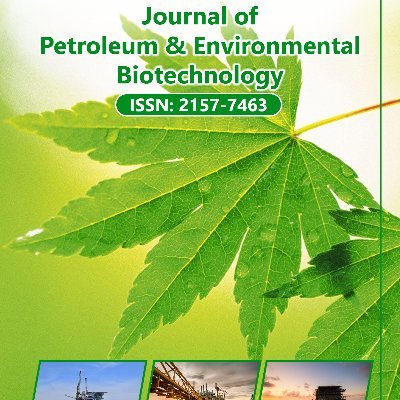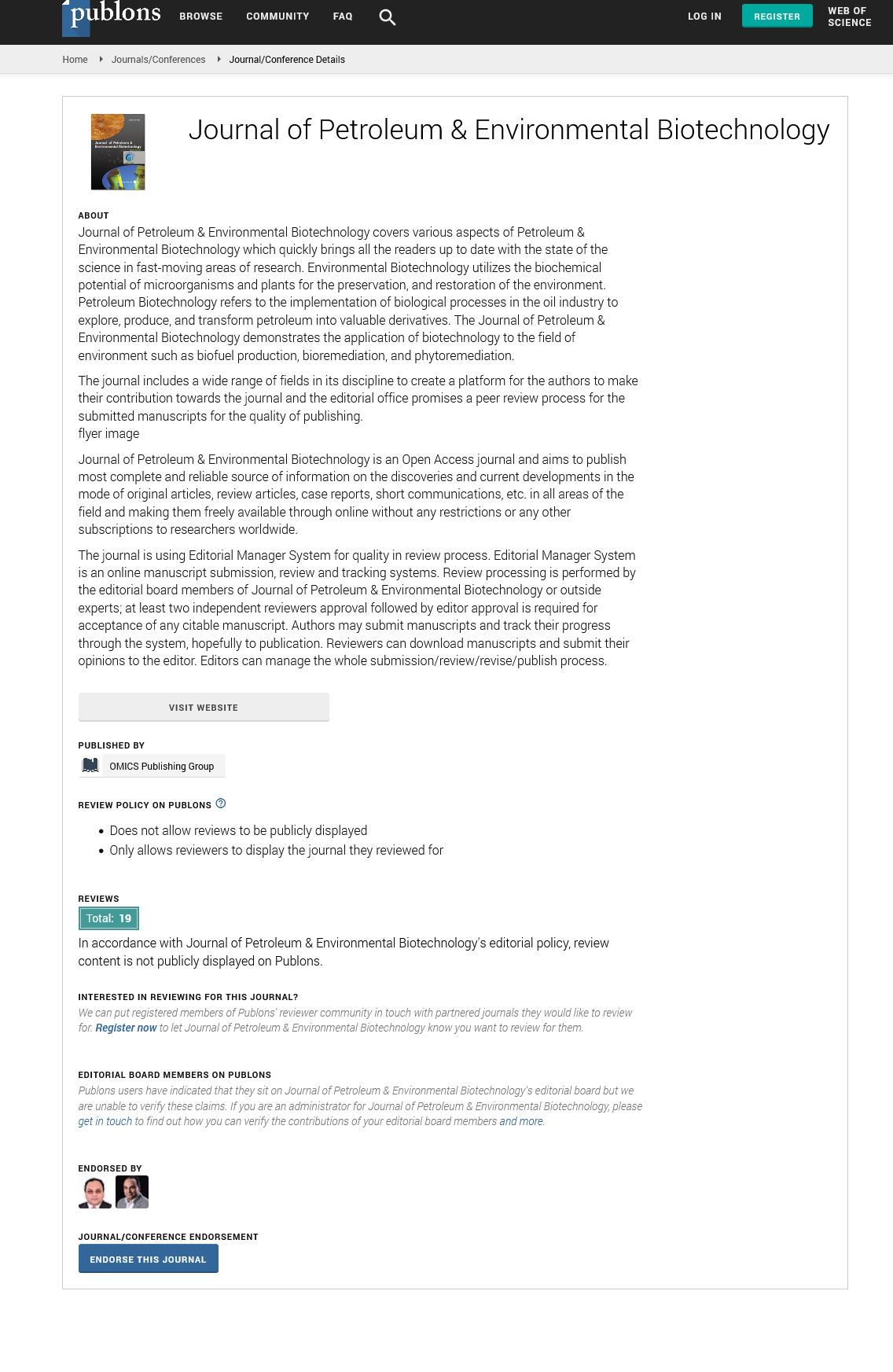Indexed In
- Open J Gate
- Genamics JournalSeek
- JournalTOCs
- China National Knowledge Infrastructure (CNKI)
- Electronic Journals Library
- RefSeek
- Hamdard University
- EBSCO A-Z
- OCLC- WorldCat
- SWB online catalog
- Virtual Library of Biology (vifabio)
- Publons
- MIAR
- Euro Pub
- Google Scholar
Useful Links
Share This Page
Journal Flyer

Open Access Journals
- Agri and Aquaculture
- Biochemistry
- Bioinformatics & Systems Biology
- Business & Management
- Chemistry
- Clinical Sciences
- Engineering
- Food & Nutrition
- General Science
- Genetics & Molecular Biology
- Immunology & Microbiology
- Medical Sciences
- Neuroscience & Psychology
- Nursing & Health Care
- Pharmaceutical Sciences
Articles published in Journal of Petroleum & Environmental Biotechnology have been cited by esteemed scholars and scientists all around the world. Journal of Petroleum & Environmental Biotechnology has got h-index 39, which means every article in Journal of Petroleum & Environmental Biotechnology has got 39 average citations.
Following are the list of articles that have cited the articles published in Journal of Petroleum & Environmental Biotechnology.
| 2024 | 2023 | 2022 | 2021 | 2020 | 2019 | 2018 | 2017 | 2016 | 2015 | 2014 | 2013 | 2012 | 2011 | 2010 | |
|---|---|---|---|---|---|---|---|---|---|---|---|---|---|---|---|
Total published articles |
40 | 56 | 60 | 53 | 18 | 16 | 31 | 38 | 61 | 57 | 35 | 43 | 34 | 12 | 4 |
Research, Review articles and Editorials |
3 | 15 | 10 | 13 | 8 | 11 | 1 | 35 | 53 | 53 | 30 | 33 | 21 | 8 | 4 |
Research communications, Review communications, Editorial communications, Case reports and Commentary |
20 | 41 | 50 | 40 | 10 | 5 | 30 | 3 | 8 | 4 | 5 | 10 | 13 | 4 | 0 |
Conference proceedings |
23 | 8 | 5 | 14 | 5 | 0 | 100 | 168 | 168 | 118 | 175 | 188 | 89 | 0 | 0 |
Citations received as per Google Scholar, other indexing platforms and portals |
488 | 589 | 699 | 790 | 653 | 601 | 563 | 460 | 389 | 349 | 171 | 70 | 20 | 36 | 0 |
| Journal total citations count | 5903 |
| Journal impact factor | 1.72 |
| Journal 5 years impact factor | 2.78 |
| Journal cite score | 20.15 |
| Journal h-index | 39 |
Important citations
Hasani zadeh P, Moghimi H, Hamedi J. Biosurfactant production by Mucor circinelloides: Environmental applications and surface?active properties. Engineering in Life Sciences. 2018 May;18(5):317-25.
Ismail W, El Nayal AM, Ramadan AR, Abotalib N. Sulfur source-mediated transcriptional regulation of the rhlABC genes involved in biosurfactants production by Pseudomonas sp. strain AK6U. Frontiers in microbiology. 2014 Aug 14;5:423.
Carrazco-Palafox J, Rivera-Chavira BE, Ramírez-Baca N, Manzanares-Papayanopoulos LI, Nevárez-Moorillón GV. Improved method for qualitative screening of lipolytic bacterial strains. MethodsX. 2018 Jan 1;5:68-74.
Ekpenyong MG, Antai SP, Asitok AD. A Pseudomonas aeruginosa strain IKW1 produces an unusual polymeric surface-active compound in waste frying oil-minimal medium. International journal of sciences. 2016;5(6):108-23.
Sa?ek K, Gutierrez T. Surface-active biopolymers from marine bacteria for potential biotechnological applications. AIMS Microbiol. 2016 Jan 1;2(2):92-107.
Banat IM, Thavasi R, editors. Microbial biosurfactants and their environmental and industrial applications. CRC Press; 2019 Jan 15.
Csutak O, Corbu V, Stoica I, Ionescu R, Vassu T. Biotechnological applications of yarrowia lipolytica cmgb32. Agriculture and Agricultural Science Procedia. 2015 Jan 1;6:545-53.
Jimoh AA, Lin J. Enhancement of Paenibacillus sp. D9 lipopeptide biosurfactant production through the optimization of medium composition and its application for biodegradation of hydrophobic pollutants. Applied biochemistry and biotechnology. 2019 Mar;187(3):724-43.
Ahmed AW, Alzubaidi FS, Hamza SJ. Biodegradation of crude oil in contaminated water by local isolates of Enterobacter cloacae. Iraqi Journal of Science. 2014;55(3):1025-33.
de Almeida Couto CR, Alvarez VM, Marques JM, de Azevedo Jurelevicius D, Seldin L. Exploiting the aerobic endospore-forming bacterial diversity in saline and hypersaline environments for biosurfactant production. BMC microbiology. 2015 Dec;15(1):1-7.
Pranaw K, Singh S, Dutta D, Chaudhury S, Ganguly S, Nain L. Biodegradation of dimethyl phthalate by an entomopathogenic nematode symbiont Xenorhabdus indica strain KB-3. International Biodeterioration & Biodegradation. 2014 Apr 1;89:23-8.
Ismail W, Shammary SA, El-Sayed WS, Obuekwe C, El Nayal AM, Raheem AS, Al-Humam A. Stimulation of rhamnolipid biosurfactants production in Pseudomonas aeruginosa AK6U by organosulfur compounds provided as sulfur sources. Biotechnology Reports. 2015 Sep 1;7:55-63.
Joo MH, Kim JY. Characteristics of crude oil biodegradation by biosurfactant-producing bacterium Bacillus subtilis JK-1. Journal of the Korean Society for Applied Biological Chemistry. 2013 Apr;56(2):193-200.
Amodu OS, Ntwampe SK, Ojumu TV. Optimization of biosurfactant production by Bacillus licheniformis STK 01 grown exclusively on Beta vulgaris waste using response surface methodology. BioResources. 2014 Jul 10;9(3):5045-65.
Zouari R, Hamden K, El Feki A, Chaabouni K, Makni-Ayadi F, Kallel C, Sallemi F, Ellouze-Chaabouni S, Ghribi-Aydi D. Protective and curative effects of Bacillus subtilis SPB1 biosurfactant on high-fat-high-fructose diet induced hyperlipidemia, hypertriglyceridemia and deterioration of liver function in rats. Biomedicine & pharmacotherapy. 2016 Dec 1;84:323-9.
Abdelli F, Jardak M, Elloumi J, Stien D, Cherif S, Mnif S, Aifa S. Antibacterial, anti-adherent and cytotoxic activities of surfactin (s) from a lipolytic strain Bacillus safensis F4. Biodegradation. 2019 Aug;30(4):287-300.
Mohanram R, Jagtap C, Kumar P. Isolation, screening, and characterization of surface-active agent-producing, oil-degrading marine bacteria of Mumbai Harbor. Marine pollution bulletin. 2016 Apr 15;105(1):131-8.
Almeida DG, Soares da Silva RD, Luna JM, Rufino RD, Santos VA, Sarubbo LA. Response surface methodology for optimizing the production of biosurfactant by Candida tropicalis on industrial waste substrates. Frontiers in microbiology. 2017 Feb 7;8:157.
Jimoh AA, Lin J. Biosurfactant: A new frontier for greener technology and environmental sustainability. Ecotoxicology and Environmental safety. 2019 Nov 30;184:109607.
Kosaric N, Sukan FV, editors. Biosurfactants: production and utilization—processes, technologies, and economics. CRC press; 2014 Nov 3.

